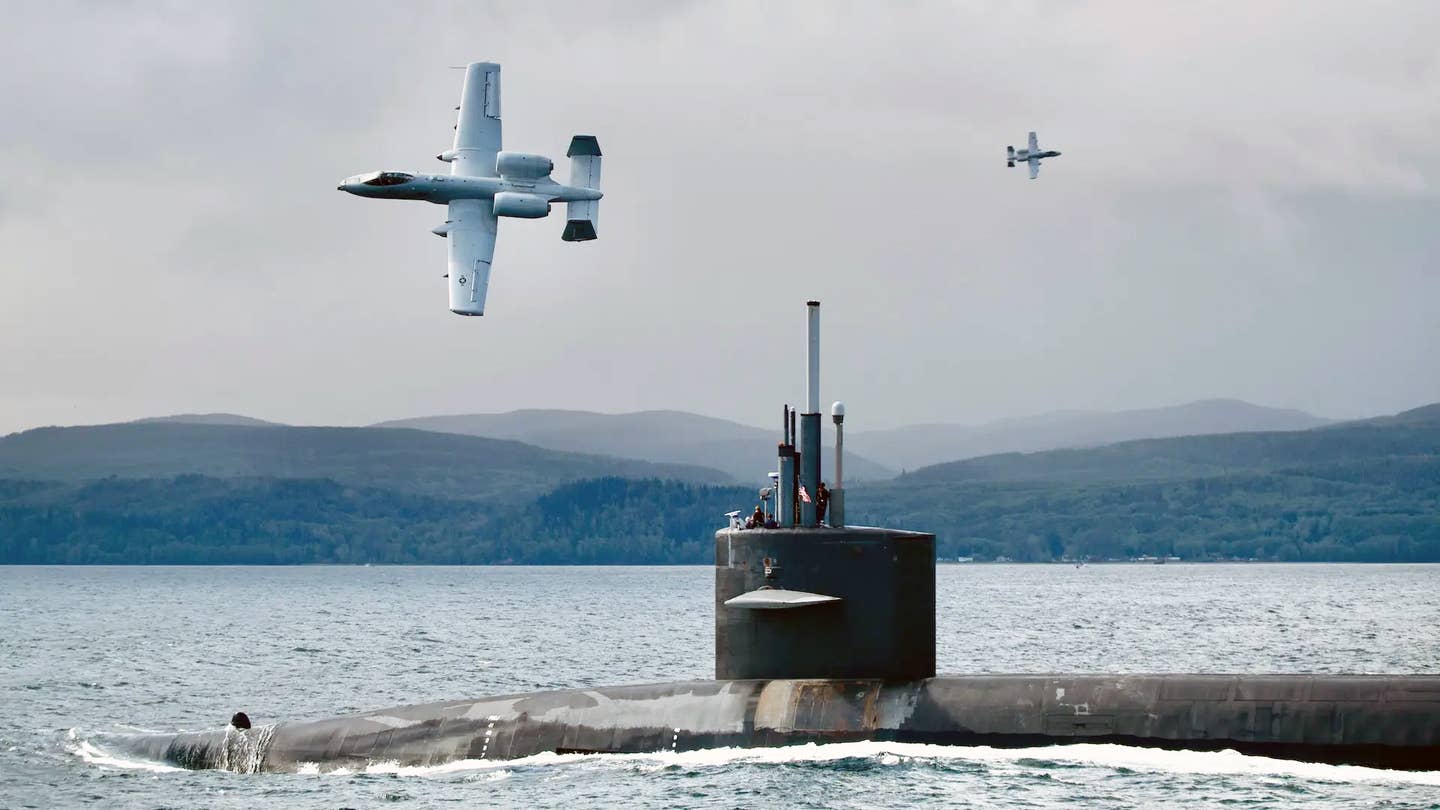A-10 Warthogs Escorting A Ballistic Missile Submarine Is Certainly Different
The A-10 is highly capable of force protection, including against boats that could threaten a submarine loaded with nuclear-tipped missiles.

When it comes to team-ups we didn't expect, Air Force A-10s and a Navy Ohio class ballistic submarine certainly is one of them. But this is exactly what went down in Washington State when USS Nebraska was escorted by a quartet of A-10 Warthogs. What exactly the A-10's mission included as part of the escort operation and how it came about remains unclear, although it was certainly a very rare sight to behold.
The visuals were posted on social media by Commander, Submarine Group 9 at Naval Base Kitsap, Washington state. They show Nebraska and its escorts transiting the Strait of San Juan de Fuca, the Salish Sea's main outlet to the Pacific Ocean, on May 6. Nebraska is one of the U.S. Navy's 14 Ohio class ballistic missile submarines (SSBNs), also known as 'boomers,' which form the sea-based leg of America's nuclear deterrence triad. The Navy also has four other Ohios, converted into conventionally armed guided missile submarines (SSGNs).
Four A-10s can be seen escorting the submarine in the photos. Two sport 'OT' tail codes, used by Nellis Air Force Base's 422d Test and Evaluation Squadron, while the other two feature 'KC' tail codes, used by Whiteman Air Force Base's 442nd Fighter Wing. The A-10s are not armed with external ordnance.
In addition, we also see one of Military Sealift Command's Submarine and Special Warfare Support Vessels, armed with an automatic cannon on its bow, escorting Nebraska in the visuals. These vessels have become common force protection and support platforms for the strategic missile boats as they come and go from their home ports.
According to the image captions, U.S. Coast Guard screening escort vessels also formed part of the operation.
Commander, Submarine Group 9 noted that "joint operations, such as this one which involved the Air Force, Coast Guard, and Navy, ensure the U.S. military is ready to meet its security commitments at home and abroad including commitments to our allies and partners." However, it does not specify what those "joint operations" consisted of, or how long they lasted. We have reached out to Submarine Group 9 and the Air Force for comment.
While further details on the training event are unknown, for the A-10s it likely provided an opportunity to practice overwatch and protection of a rare and extremely high-value strategic asset. The low-flying, slow-speed capabilities of the Warthog, combined with its loitering ability and extreme air-to-ground precision, make it a uniquely capable force-protection platform. We know that A-10s have been specifically used to target swarms of boats and striking small naval vessels in past training exercises, drawing on those capabilities. These are the exact types of asymmetric threats boomers could face while traveling exposed on the ocean's surface.
Conducting force-protection training with Nebraska would make sense, given that the A-10 community has been looking for ways to show its relevance outside of lower-intensity conflicts overseas. The Air Force plans to retire the whole A-10 fleet by the end of the decade, if not before. However, we cannot be sure for certain to what extent this type of training was actually conducted on May 6. It's just as possible that the A-10s conducted a few passes of Nebraska and did some basic integration work; we simply don't know.
Whatever the specific purpose of the exercise, the Air Force A-10s and vessels seemingly took the opportunity to train with Nebraska prior to the submarine's departure for a nuclear deterrence patrol in the Pacific.
As previously mentioned, the Navy's Ohio class SSBNs form a critical component of America's nuclear triad. Each Ohio class SSBN was originally designed to carry a maximum of 24 Trident D5 nuclear-armed submarine-launched ballistic missiles (SLBMs), known as Trident IIs. However, that number was reduced to a maximum of 20 in 2017 due to the signing of an arms control agreement with Russia. You can read more about the U.S.'s Trident IIs, and their warhead configurations, here.
It should be noted that the U.S. is expected to receive an entirely new class of SSBN, the Columbia class, through 2032, which will continue to be armed with Trident IIs. The first of those new boats is expected to be delivered by 2027.
In recent years, the Navy has been more actively advertising the activities of its boomers outside the U.S. — which The War Zone has been monitoring closely — in order to send messages to its adversaries. As Navy Rear Adm. Jeffrey Jablon, commander of Submarine Force, U.S. Pacific Fleet (SUBPAC) said at the end of last year, he no longer sees the U.S. submarine force as a "silent service."
"Deterrence is a major mission for the submarine force," Jablon told Breaking Defense. "You can’t have a credible deterrent without communicating your capabilities; if the adversary doesn’t know anything about that specific deterrent, it’s not a deterrent."
Previously, for example, we saw the Ohio class SSBN USS Tennessee sailing in the Atlantic with an unspecified Royal Navy Vanguard class SSBN in late 2022, in what was a rather unusual show of force at the time.
Whatever the exact reason for the A-10's involvement in the recent exercise with Nebraska, seeing these iconic aircraft alongside a boomer is certainly an unexpected, but welcome, sight.
Contact the author: oliver@thewarzone.com
